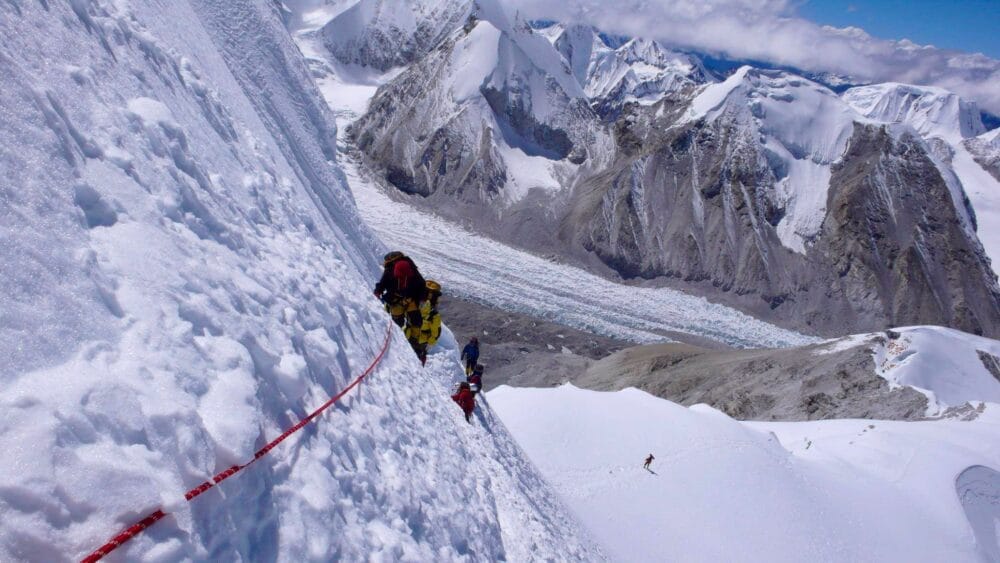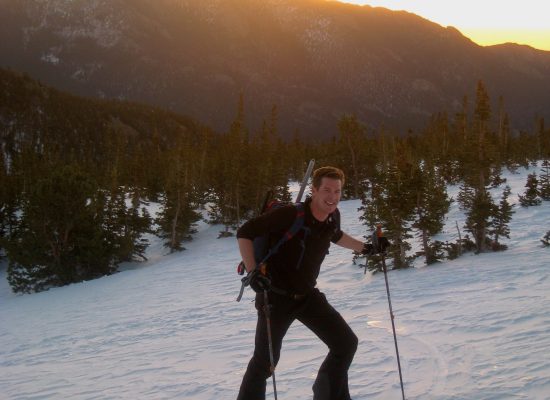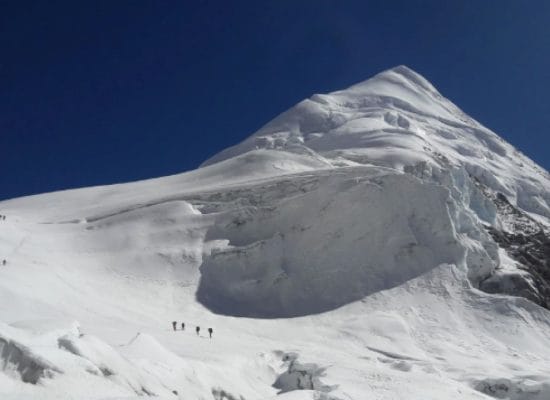The Pakistani government has issued an exhaustive report on the July 27, 2023, death of Pakistani High Altitude Porter, Mr. Muhammad Hassan. While no one team or individual was found culpable, it exposed deep issues across the mountaineering industry that must be fixed.
It is sad and interesting reading that didn’t find any one person or team solely responsible for his death but haphazard coordination among the operators, ignoring long-established Pakistani climbing rules, and a lack of training and resources. All complicated by a sudden storm at the steepest and most dangerous terrain of the mountain.
The Report’s Findings
Mr. Hassan was climbing with a fifteen-person rope-fixing team made up of highly experienced Nepali Sherpas from multiple commercial teams. Mr. Hassan had no climbing or high-altitude experience. His previous experience was trekking around K2 and Spantik. The reports noted he was wearing normal trousers and a jacket while climbing between C2 and C3. Unlike the rest of the rope-fixing team, he was not wearing a down suit, using supplemental oxygen, or even wearing a helmet on the rock-fall-prone route.
As they approached the most dangerous part of a K2 climb on the Abruzzi route, he lagged the rope team carrying a large load of rope and other supplies. Then between 12:00 a.m. and 2:00 a.m., he fell five to seven meters downward from the narrow boot path on a 70-degree angle snow slope, aka the Traverse, pulling out a snow screw that attached the fixed rope to the mountain. His carabiner and jumar that were attached to the rope stopped his fall.
With avalanches all around the rope team, plus a developing snowstorm, the rope team continued fixing the ropes toward the summit; however, two Sherpas stayed behind to pull him back to the boot path but were unsuccessful. They soon left to join the other rope fixers, leaving Mr. Hassan hanging upside down, according to the report. There were about 200 climbers making their way to the summit from Camp 3 in the early morning hours of July 27, 2023.
Kristin Harila’s team, made up of Tenjen “Lama” Sherpa and photographer Gabriel Tarso Silva, came upon a long line of climbers stopped in the Bottleneck, which is just below the Traverse. Ahead of them, apparently, they saw Mr. Hassan hanging from the fixed rope. No one knew how to or could not help, so they just stood in place, not able to pass the porter hanging from the fixed rope. Harila’s team moved ahead of the queue to assess the situation. As they got closer, Tarso reported hearing “groans of pain.” They found him hanging upside down with no down suit, helmet, gloves or oxygen. The report says he had been in this position for over an hour.
Tarso’s report said he and Tenjen, along with Mr. Hassen’s companion, Hassam Shighri, rigged a 3:1 pulley system out of the climbing tools with them. They eventually pulled him back to the boot path and provided aid. Harila’s team heard an avalanche had hit the rope-fixing team, so she and Tenjen left to investigate, leaving Tarso, his companion and another Sherpa from 8K Expeditions with Mr. Hassan.
The report states, “Climbers noticed that late Hassan’s abdomen remained exposed in extreme cold temperature upside down concentration of his body fluid caused his body faint restricted survivability.” Tarso noted he was hypothermic and appeared to have broken both legs in the fall with his harness down on his legs preventing him from moving.”
Led by Tarso, they attempted to save his life amid a fierce snowstorm. Tarso shared his supplemental oxygen and provided him gloves and warm water, but he became unresponsive. The storm impeded radio communications. Tarso reported that while they were working on him, other climbers passed by and asked, “Could you go to the side so I can pass, please?”
Muhammad Hassan died in the early morning at 8200 meters.
Tarso, running out of oxygen, was not acclimatized to this altitude and would die if he didn’t find more soon. The closest source was a Sherpa on their larger team from Seven Summits Treks, now higher on the mountain carrying an extra bottle. As he left Mr. Hassan, Tarso reported, “Looking into his eyes, now with almost no sparkle, I realized that perhaps there was no more hope for porter Muhammad Hassan.”
The report includes a long list of changes needed to the decades-old climbing regulations. It recognized the loss to Mr. Hassan’s family and asked the local authorities to compensate them. The report concluded that Lela Peak Expeditions Tour Operator violated multiple regulations by not providing proper “kit to HAP, hiring an inexperienced HAP, and not having required insurance.” They have been banned from operating in Pakistan for two years. Gabriel Tarso received an “appreciation letter” for his effort to save a life that night.
While not cited in the report, it appears that Mr. Hassan used his gear money and joined the rope team to earn more money to support his family of four and his mother, who has diabetes.
This is the full report for download: Muhammad Hussain’s Death on K2
A GoFundMe account is open for donations to support Mr. Hassan’s family.
My Opinion
I have held back making a lot of public comments wanting to see what this report found. There was too much speculation, guessing and blaming to speak out too early. The report matches what I’ve been told by those there and others in the industry.
A report like this is rare from government authorities in my experience, I appreciate the depth and details as the outdoor and mainstream media has misplaced blame on Harila’s team. The report shows they did everything they could, and given his condition, most likely even with a rescue, he would have perished.
However, many questions remain on why he was put in this situation. Why did climbers feel it was acceptable to step over Mr. Hassan? Did anyone offer help to Tarso and others helping him? Why did the rope team accept his offer to help? What was the role of the Liaison Officers there supposedly to enforce all regulations? Were the commercial team’s leaders, especially the high-profile ones who often brag about how many people they rescue, aware of the unfolding disaster?
I have both been at that exact spot and have first-hand knowledge of the terrain and how difficult it would have been. I assume if every Sherpa and Pakistani High-Altitude climber available that night had banded together (99% of the foreigners there lacked the strength to make a significant difference), they could have moved him to C4 or C3, but then you have to navigate the Black Pyramid and House Chimney, before getting to an altitude where a helicopter evacuation would have been possible. It would have been hard but not impossible.
Extreme altitude rescues are complex, and I believe the choices belong to the individual at that moment. When considering the physical, mental and emotional challenges of climbing above 8000 meters, there are no simple answers despite the moral considerations.
I have pondered the very question of what I would do if I came upon a climber in need. Well, I have, and I gave aid to the extent of my capabilities. However, I’ve never come upon anyone near Mr. Hassan’s circumstances. I know from standing at the very spot on the Traverse where he died that if I came upon him, I would have stopped as the Norwegian team did, do what I could, but also being realistic based on my experiences when I was there, it was all I could do to move, much less try to pull a 150-pound human up a steep snow wall. Would I have continued or turned back? To be honest, I don’t know, but I would have stayed as long as I could have been useful.
I think this is one of those “you got to be there” things. The analogy I use is that when you are driving on a highway and see a horrific crash ahead of you. Aid is there, so what do you do? Stop and return home? Stop and try to help. Slow down and respectfully pass the incident, then continue to your original destination.
It’s easy for arm-chair climbers to critique those who were there and the climbing community. Some cite examples where teams have stopped their climb and helped a climber or given up their summit to help others. The cases of David Sharp, Lincoln Hall, and the inspiring moment on K2 known as “The Belay” that coined the phrase “Brotherhood of the Rope” come to mind. So could Mr. Hassan’s life have been saved if a rescue team had brought him lower immediately after he fell? Perhaps, but we’ll never know. However, I still believe there is good in the industry, climbers who follow a moral code such as we saw on July 27, but there is also a need to prevent this from ever happening again.
Like so many deaths on 8000-meter mountains in these modern times, this was an avoidable death.
This is a sport I love. It’s changed my life for the better, but it’s broken. Seventeen people lost their lives on Everest this past spring. At least eleven were avoidable, in my opinion. One death on K2 is historically low, but it was also avoidable.
We need to ask more questions and hold operators and governments accountable for who gets our money. Most businesses don’t change unless they see a threat to their business. Before you select your next expedition operator, ask them a few questions:
- If we see a climber on another team in trouble, how will you handle it?
- Will we cancel a summit push to give aid to another team?
- If I get in trouble, am I on my own?
Clients on the lowest-cost teams need to ask if they pay the staff at the market rate. Do they have insurance? Do they have the proper gear? Are they trained for the job they are asked to perform?
For those on the high-end teams, the same questions but go into the cooking tent and talk to the kid who gets snow or ice each day for drinking and cooking water. Is he paid well? Treated well? Look at his shoes and jacket. Talk to the porter who carried twice his body weight to your base camp on how he is paid and treated. Leadership comes from the top.
Mr. Hassan‘s death was not the fault of one person it was the fault of all of us who claim the sport as our own. The sport is in trouble and needs strong leadership.
We can do better. We must do better.
My deep condolences to Mr. Hassan’s family,
Climb On!
Alan
Memories are Everything
The Podcast on alanarnette.com
You can listen to #everest2022 podcasts on Spotify, Apple Podcast, Google Podcasts, Pocket Casts, RadioPublic, Anchor, and more. Just search for “alan arnette” on your favorite podcast platform.
Summit Coach
Schedule a Free Call
 If you dream of climbing mountains but are not sure how to start or reach your next level, from a Colorado 14er to Rainier, Everest, or even K2, we can help. Summit Coach is a consulting service that helps aspiring climbers throughout the world achieve their goals through a personalized set of consulting services based on Alan Arnette’s 25 years of high-altitude mountain experience, including summits of Everest, K2, and Manaslu, and 30 years as a business executive.
If you dream of climbing mountains but are not sure how to start or reach your next level, from a Colorado 14er to Rainier, Everest, or even K2, we can help. Summit Coach is a consulting service that helps aspiring climbers throughout the world achieve their goals through a personalized set of consulting services based on Alan Arnette’s 25 years of high-altitude mountain experience, including summits of Everest, K2, and Manaslu, and 30 years as a business executive.





4 thoughts on “K2 2023 Coverage: Harila and Tenjen Cleared on Muhammad Hassan’s Death”
Surely if you’re climbing as part of a team, then the first responsibility to look after you is from other members of that team? It sounds from your post like the rope fixing team he was climbing with pretty quickly abandoned him to get on with rope fixing. Once that happened, it was difficult for anyone else to help because the clients would quite sensibly “leave it to the experts”, and the experts on each team had their own clients to look after. So you’re reliant on there being some non-commercial climbers around to fix the problems.
If someone on a rope fixing team has problems, then the rope fixing team should prioritise helping them, and give up on fixing ropes, even if that means everyone else’s summit is off. I can’t help wondering if this climber’s perceived low status on the team was part of the reason he got left.
I thought it was evident that Lela’s Pak Expeditions was primarily at fault for all of the reasons noted in the full report – Hassan wasn’t on the permit and had no high-altitude gear or training. I do not understand why the Fact-Finding Committee under the Secretary of Tourism did not mandate Lela’s Pak to provide the contact information of the other Sherpas so that their recollections of the event could be considered. Was there no way to enforce this? In the US, a subpoena and an obstruction charge would be filed for those not cooperating. I understand these are different countries, different regulations, of course. I assume they had no authority to do so? But because the outcome of the investigation did not find fault, it will happen again, regardless of how the rules are changed, until accountability is assigned. This is another sad commentary on human nature and climbing the higher peaks.
Thanks Alan. This makes a lot of sense. I’m an armchair only climber and it seemed to me that the situation was far more complex than it appeared in the press. I don’t think any of us who stay more or less at sea level can imagine what it would be like in such a situation. That said, I think Kristan has been badly advised by PR people – I’m giving her the benefit of the doubt here. Her responses have sounded a bit hollow to me. This young man died tragically but she couldn’t seem to resist playing the victim card. Her most recent post on Instagram is all about her and how hard things have been for her. I think the occasion calls for more contrition on her part and some acknowledgement that there are questions to be answered about how porters and helpers are treated. She is in a difficult position, no question, but she has an opportunity to start an important discussion. Her courage on the mountain is beyond question. I wonder if she is brave enough to drop the ‘damage control’ language and say some things that probably need to be said. Don’t get me wrong, I admire her and I think that there is some evidence that, as a woman climber, she has been a target for abuse. But I also think she needs to find a way to talk about this in a way that it is about Hassan and the other porters rather than about her. Unfair? Happy to hear other views.
Thanks, Tony, for your respectful and thoughtful comment. I’ll ask Kristen your question when I have her on my podcast. If you haven’t read her full description on her website, please do it may give you a different perspective. https://kristinharila.com/what-happened-on-k2-27-07-2023/
Comments are closed.